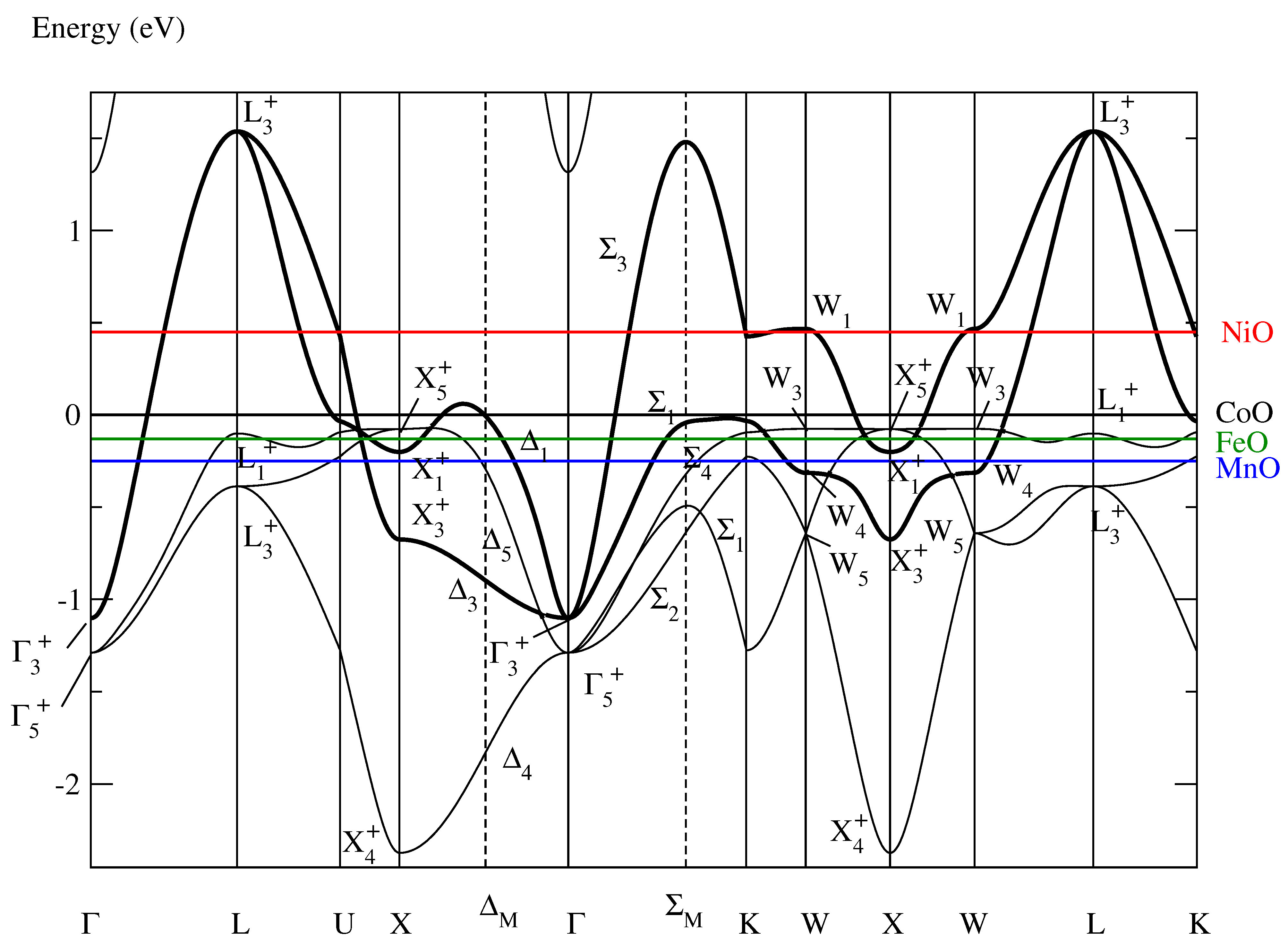Magnetic Bands Producing a Monoclinic Magnetic Structure in NiO, FeO, MnO, and a Tetragonal One in CoO
Abstract
:1. Introduction
2. Paramagnetic CoO, NiO, FeO, and MnO
- being roughly half-filled,
- comprising all the Bloch electrons at the Fermi level, and
- defining Bloch functions which can be unitarily transformed into Wannier functions that
- –
- are adapted to the fcc structure,
- –
- possess the two-dimensional symmetry,
- –
- are optimally localized, and
- –
- are situated on the Co atoms.
- An insulating band defining Wannier functions with the two-dimensional symmetry exists neither in paramagnetic FeO nor in MnO because in these materials the Bloch states with , , , and symmetry lie above the Fermi energy. Thus, in FeO and in MnO more than two branches cross the Fermi level and, consequently, the optimally localized and symmetry-adapted Wannier functions have a five-dimensional symmetry [11] because we demand that the band comprises all the Bloch electrons at the Fermi level.
3. Magnetic Bands
3.1. CoO
3.2. MnO
- possesses eight Mn atoms and eight O atoms in the unit cell and
- is invariant under the magnetic group in Equation (1).
3.3. FeO
3.4. NiO
- Band red:
- Defined by the bold lines in black and in red.
- Band green:
- Defined by the bold lines in black and in green.
4. Discussion
Funding
Institutional Review Board Statement
Informed Consent Statement
Data Availability Statement
Acknowledgments
Conflicts of Interest
Abbreviations
| NHM | Nonadiabatic Heisenberg model |
| I | Inversion |
| K | Antiunitary operator of time inversion |
References
- Rooksby, H. A note on the structure of nickel oxide at subnormal and elevated temperatures. Acta Crystallogr. 1948, 1, 226. [Google Scholar] [CrossRef]
- Shull, C.G.; Strauser, W.A.; Wollan, E.O. Neutron Diffraction by Paramagnetic and Antiferromagnetic Substances. Phys. Rev. 1951, 83, 333–345. [Google Scholar] [CrossRef]
- Roth, W.L. Magnetic Structures of MnO, FeO, CoO, and NiO. Phys. Rev. 1958, 110, 1333–1341. [Google Scholar] [CrossRef]
- Cracknell, A.P.; Joshua, S.J. The space group corepresentations of antiferromagnetic NiO. Math. Proc. Camb. Philos. Soc. 1969, 66, 493–504. [Google Scholar] [CrossRef]
- van Laar, B. Multi-Spin-Axis Structure for CoO. Phys. Rev. 1965, 138, A584–A587. [Google Scholar] [CrossRef]
- Timm, L.; Tucker, M.G.; Keen, D.A.; Thygesen, P.M.M.; Saines, P.J.; Goodwin, A.L. Exploration of antiferromagnetic CoO and NiO using reverse Monte Carlo total neutron scattering refinements. Phys. Scr. 2016, 91, 114004. [Google Scholar] [CrossRef] [Green Version]
- Jauch, W.; Reehuis, M.; Bleif, H.J.; Kubanek, F.; Pattison, P. Crystallographic symmetry and magnetic structure of CoO. Phys. Rev. B 2001, 64, 052102. [Google Scholar] [CrossRef]
- Krüger, E. Nonadiabatic extension of the Heisenberg model. Phys. Rev. B 2001, 63, 144403. [Google Scholar] [CrossRef] [Green Version]
- Krüger, E. Magnetic Structure of CoO. Symmetry 2021, 13, 1513. [Google Scholar] [CrossRef]
- Krüger, E. Structural Distortion Stabilizing the Antiferromagnetic and Insulating Ground State of NiO. Symmetry 2019, 12, 56. [Google Scholar] [CrossRef] [Green Version]
- Krüger, E. Nonadiabatic Atomic-Like State Stabilizing Antiferromagnetism and Mott Insulation in MnO. Symmetry 2020, 12, 1913. [Google Scholar] [CrossRef]
- Bradley, C.; Cracknell, A.P. The Mathematical Theory of Symmetry in Solids; Claredon: Oxford, UK, 1972. [Google Scholar]
- Blum, V.; Gehrke, R.; Hanke, F.; Havu, P.; Havu, V.; Ren, X.; Reuter, K.; Scheffler, M. Ab initio molecular simulations with numeric atom-centered orbitals. Comput. Phys. Commun. 2009, 180, 2175–2196. [Google Scholar] [CrossRef] [Green Version]
- Havu, V.; Blum, V.; Havu, P.; Scheffler, M. Efficient O(N)O(N) integration for all-electron electronic structure calculation using numeric basis functions. Comput. Phys. Commun. 2009, 228, 8367–8379. [Google Scholar] [CrossRef]
- Krüger, E.; Strunk, H.P. Group Theory of Wannier Functions Providing the Basis for a Deeper Understanding of Magnetism and Superconductivity. Symmetry 2015, 7, 561–598. [Google Scholar] [CrossRef] [Green Version]
- Krüger, E. Energy band with Wannier functions of ferromagnetic symmetry as the cause of ferromagnetism in iron. Phys. Rev. B 1999, 59, 13795–13805. [Google Scholar] [CrossRef]


Publisher’s Note: MDPI stays neutral with regard to jurisdictional claims in published maps and institutional affiliations. |
© 2022 by the author. Licensee MDPI, Basel, Switzerland. This article is an open access article distributed under the terms and conditions of the Creative Commons Attribution (CC BY) license (https://creativecommons.org/licenses/by/4.0/).
Share and Cite
Krüger, E. Magnetic Bands Producing a Monoclinic Magnetic Structure in NiO, FeO, MnO, and a Tetragonal One in CoO. Symmetry 2022, 14, 1285. https://doi.org/10.3390/sym14071285
Krüger E. Magnetic Bands Producing a Monoclinic Magnetic Structure in NiO, FeO, MnO, and a Tetragonal One in CoO. Symmetry. 2022; 14(7):1285. https://doi.org/10.3390/sym14071285
Chicago/Turabian StyleKrüger, Ekkehard. 2022. "Magnetic Bands Producing a Monoclinic Magnetic Structure in NiO, FeO, MnO, and a Tetragonal One in CoO" Symmetry 14, no. 7: 1285. https://doi.org/10.3390/sym14071285






